When I’m asked what I do for a living, I debate in my head how to answer the question. Should I say: “I’m an SEO” and wait for the inevitably confused look?
Perhaps I should go with my wife’s answer, instead: “He organizes the internet to get high rankings on Google.” You have to admit, anyone who can organize the internet is probably pretty cool.
Should I keep my answers brief, or should I take a little time and educate them about the awesomeness of SEO?
Many professionals in this industry still find it challenging to explain to someone in a different field exactly what they do. Then again, when my wife, a nurse, comes home and tries to share stories and challenges from her day, I feel like she’s speaking a foreign language. So maybe it’s the same for any profession.
In the SEO industry, however, communication and clarity are important. Hopefully, I can clearly answer the question: “What is an SEO Specialist?”
Search Engine Optimization (SEO) helps people find products and information on search engines like Google and Bing. An SEO specialist, then, researches and analyzes the trends and best practices online to develop and implement strategies that improve search results.
The overall goal is to increase the level of traffic to a website by using keywords and keyword topics to improve the user experience and meet search engine guidelines.
Search engines, however, are always changing. And SEO specialists have to keep up. Let’s think about what exactly we mean by this.
Consider, for example, a search for the keyword: “SEO.”
Back in the day, the search results looked something like this:
At the time (2011ish) SEO.com ranked third in the search results. You’ll also notice that aside from Google’s own entry and Wikipedia’s definition, the other results are all SEO companies.
These days, the results are a bit different for the same search. Now, this is what it looks like above the fold:


